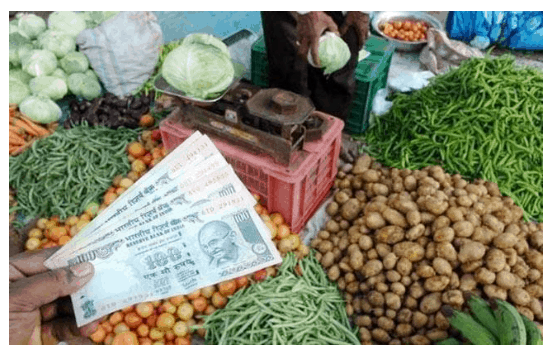UPSC Articles
Indian Economy
TOPIC:General Studies 3:
- Indian Economy and issues relating to planning, mobilization, of resources, growth, development and employment.
Daily Current Affairs IAS | UPSC Prelims and Mains Exam – 15th January 2020
Inflation
Context:
- Consumer price inflation (Retail inflation) has touched a high of 7.35% in December which has set off fears over whether India is entering a period of slow growth accompanied by high inflation, in other words, stagflation.
Inflation is defined as a situation where there is sustained, unchecked increase in the general price level of goods and services in an economy
Indices which measure inflation in an economy
Wholesale Price Index (WPI)
- WPI measures the changes in the prices of goods sold and traded in bulk by wholesale businesses to other businesses. In other words, WPI tracks prices at the factory gate before the retail level.
- The numbers are released by the Ministry of Commerce and Industry
- Even as the WPI is used as a key measure of inflation in some economies, the RBI no longer uses it for policy purposes, including setting repo rates.
Consumer Price Index (CPI) – Retail Inflation
- It is an index measuring retail inflation in the economy by collecting the change in prices of most common goods and services used by consumers.
- It is released by Central Statistics Office (CSO) under Ministry of Statistics and Programme implementation
- In April 2014, the RBI had adopted the CPI as its key measure of inflation
What is the difference between WPI & CPI?
- WPI, tracks inflation at the producer level and CPI captures changes in prices levels at the consumer level.
- Both baskets measure inflationary trends (the movement of price signals) within the broader economy, the two indices differ in which weightages are assigned to food, fuel and manufactured items.
- WPI does not capture changes in the prices of services, which CPI does.
Headline Retail Inflation vs Core Inflation
- Headline inflation is the raw inflation figure reported through the Consumer Price Index (CPI) that is released by CSO. The headline figure is not adjusted for seasonality or for the often-volatile elements
- Core inflation removes the CPI components that can exhibit large amounts of volatility from month to month, which can cause unwanted distortion to the headline figure. The most commonly removed factors are those relating to the cost of food and energy.
Concern for RBI
- Price stability in an economy is one of the major responsibility of the Central Bank. Untamed inflation will eventually erode confidence in an economy thus derailing economic growth.
- The December inflation is also way above the monetary policy committee’s (MPC) mandated limit of CPI at 6% (4% plus 2%)
- High inflation means RBI is constrained to cut rates (repo rate) further especially when there is pressure on the central bank to cut rates at least one more time to stimulate growth (projected GDP growth for FY-2020 is just 5%)
What is the reason for unexpected inflation in December?
- The headline inflation number is driven mainly by food inflation at 14.12%
- Since the overall retail inflation has 45.86 per cent of food articles, the overall CPI has also shot up.
- Heavy rains from september to November 2019 has caused heavy damage to the standing Kharif crops leading to supply shortage and thus driving up the food prices
- Onion pushed up price inflation in vegetables to a huge 60.50% compared to December 2018, prices of other food items such as meat and fish (up 9.57%), milk (up 4.22%), eggs (up 8.79%) and some pulses were also on the upswing.
- Minus the increase in prices of onion, potato and ginger, headline CPI inflation would be just 4.48%.
- Core inflation, which is the one that should be of concern, has only inched up marginally from 3.5% in November to 3.7% in December.
Is High Food inflation going to continue in near future?
- High prices of vegetables being mostly seasonal and short-duration are expected to fall in the coming months.
- The prices will reverse once the supply shortfall is addressed.
Food price may ease due to same reason it rose
- Heavy rains in recent months have helped to recharge groundwater aquifers, and filled the major irrigation reservoirs to near full capacity, proving beneficial to the rabi crop
- Data shows that there has been 8 per cent more area sown and this coupled with the improved soil moisture conditions and a normal winter, is expected to translate into a bumper harvest, offsetting any Kharif losses and cutting the food prices
Caution
- One major factor that can still keep the customers paying more for the food articles is a turbulence in the global prices as the UN Food and Agricultural Organisation’s Food Price Index (base year: 2002-04 = 100) averaged 181.7 points in December 2019, the highest since the 185.8 level of December 2014.
- This reflected a hardening trend in the international prices of food items which makes imports of food articles (like Palm oil, pulses) costlier.
Way Ahead
- Climate resilient agriculture which is able to better adapt to frequent climate extremities.
- Better collaboration at international level to ensure that essential food articles are distributed evenly across the globe where at present we have wastage on one hand & hunger/shortage on other hand
Connecting the Dots
- FAO index rise is driven largely by which food components and its bearing on Indian domestic economy
- Is high food prices impact on famers income and thus boosting rural demand ?















